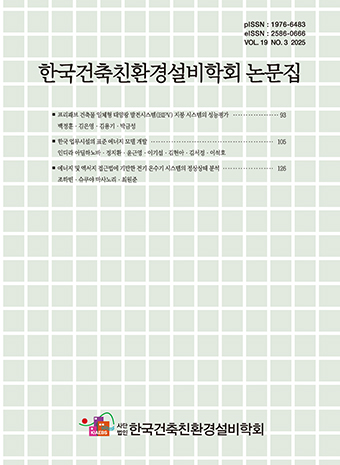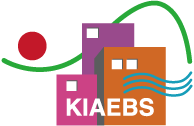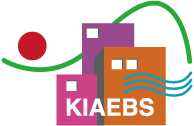-
Research Article

-
Performance Evaluation of a Prefabricated BIPV System
프리패브 건축물 일체형 태양광 발전시스템(BIPV) 지붕 시스템의 성능평가
-
Baek, Cheong-Hoon, Kim, Eun-Young, Kim, Yong-Ki, Park, Keum-Sung
백정훈, 김은영, 김용기, 박금성
- This study aims to develop a prefabricated BIPV roof system, in which most processes are completed in a factory and only simple …
- This study aims to develop a prefabricated BIPV roof system, in which most processes are completed in a factory and only simple installation is required on-site, as an alternative to the conventional BIPV method where all processes are carried out on-site. The effectiveness of the system is verified through performance evaluation. The waterproofing performance evaluation confirmed that the three-stage waterproof structure effectively prevented water infiltration. Additionally, fire resistance tests demonstrated satisfactory results, with load-bearing capacity at 55 minutes, integrity at 55 minutes, and insulation at 50 minutes, thus fully meeting established standards. The thermal insulation performance evaluation revealed that some performance criteria were not satisfied due to thermal bridge occurrences. Consequently, further research, including the application of thermal break materials, is required for applicability in general buildings. The developed system significantly reduced installation time by up to 98% compared to conventional on-site installation methods, highlighting its strong suitability for environments such as industrial complexes that require rapid construction. In conclusion, the developed prefabricated BIPV system has proven to offer rapid installation, excellent maintenance convenience, and superior waterproofing and fire resistance performance. Future improvements in thermal insulation and system flexibility are necessary to extend its applicability across various architectural environments. - COLLAPSE
-
Performance Evaluation of a Prefabricated BIPV System
-
Research Article

-
Development of Reference Energy Models for Office Buildings in Korea
한국 업무시설의 표준 에너지 모델 개발
-
Indira Adilkhanova, Jeong, Ji-Hwan, Yun, Geun-Young, Lee, Ki-Sup, Kim, Hyun-Ah, Kim, Seo-Jeong, Lee, Suk-Ho
인디라 아딜하노바, 정지환, 윤근영, 이기섭, 김현아, 김서정, 이석호
- This study presents the development of regionally representative reference models for office buildings in Korea using a hierarchical clustering method. Office buildings …
- This study presents the development of regionally representative reference models for office buildings in Korea using a hierarchical clustering method. Office buildings in Seoul and Gyeonggi-do were classified into two dominant categories: mid-rise and high-rise, based on key geometric parameters extracted from the national building registry. For each category, detailed EnergyPlus models were created, incorporating geometry, zoning configuration, window-to- wall ratios, and envelope assemblies aligned with domestic thermal performance standards. Annual energy simulations showed clear differences in heating and cooling demand between the two types, underscoring the importance of capturing geometric and operational diversity in building energy modelling. The proposed approach provides a practical foundation for developing detailed reference models suitable for building energy simulations, policy analysis, and scenario evaluation. - COLLAPSE
-
Development of Reference Energy Models for Office Buildings in Korea
-
Research Article

-
Steady-State Energy and Exergy Analyses of an Electric Resistance Water Heater System
에너지 및 엑서지 접근법에 기반한 전기 온수기 시스템의 정상상태 분석
-
Jo, Habin, Shukuya, Masanori, Choi, Wonjun
조하빈, 슈쿠야 마사노리, 최원준
- As building insulation improves, the share of energy used by domestic hot water systems increases, elevating the importance of their efficiency. Conventional …
- As building insulation improves, the share of energy used by domestic hot water systems increases, elevating the importance of their efficiency. Conventional energy analysis, focusing solely on energy quantity, provides insufficient insight into system inefficiencies. Exergy analysis, which considers both the quantity and quality of energy, offers a more comprehensive understanding of thermodynamic performance. Despite their global prevalence, electric resistance water heaters have received limited attention in exergy research, which has predominantly addressed heat pump systems. To address this research gap, this study develops a steady-state exergy model for an electric resistance water heater and compares the outcomes of energy and exergy analyses to assess how the system utilizes energy from both quantitative and qualitative perspectives. The exergy analysis reveals that significant inefficiency arises from the conversion of high-quality electrical energy to low-quality thermal energy. Additionally, the water mixing process destroys approximately 22% of the final service hot water’s exergy. This research contributes to a better understanding of how the electric resistance water heater system operates in terms of both energy quantity and quality. It also supports the development of more efficient strategies for utilizing electrical energy in domestic hot water applications. - COLLAPSE
-
Steady-State Energy and Exergy Analyses of an Electric Resistance Water Heater System
Journal Informaiton
 Journal of Korean Institute of Architectural Sustainable Environment and Building Systems
Journal of Korean Institute of Architectural Sustainable Environment and Building Systems
Journal Informaiton
Journal Informaiton - close
 Journal of Korean Institute of Architectural Sustainable Environment and Building Systems
Journal of Korean Institute of Architectural Sustainable Environment and Building Systems











